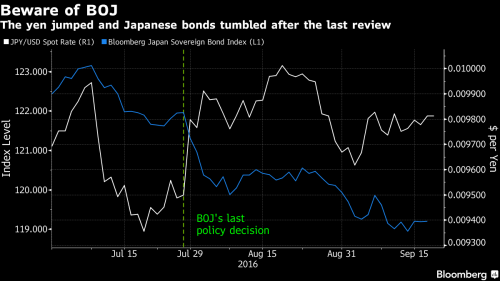If yesterday one could “explain” the overnight stock levitation due to the move higher in crude oil, today there is no such catalyst with WTI down modestly, and yet the broader push higher across European stocks and US equities has reappeared following yesterday’s muted close on Wall Street ahead of key central bank data on deck. Some have attributed the 0.4% rise in futures to the latest dip in the dollar, while a modest bond rally as the countdown to crucial policy decisions by the Bank of Japan and the Federal Reserve entered its final stretch, put taper tantrum concerns on hold if only for the time being.
Indeed, it is all about the two key central bank meetings over the next 24 hours, with both the BOJ and Fed set to make highly anticipated policy decisions. As DB’s Jim Reid puts it, “tomorrow is going to be a bit of a Hollywood day in markets with the FOMC conclusion and the BoJ meeting. In 24 hours we’ll know the Japanese decision and we’ll be awaiting the press conference from Kuroda at 7.30am BST.” DB thinks the BOJ they’ll refrain from adding more stimulus this month. While the bank’s Japan economists acknowledge all the noise from the various media outlets reporting that the BoJ is considering a change in its JGB purchasing scheme to spur a steepening in the curve, a deepening of NIRP and a new forward guidance strategy, they think that the BoJ will do little more than indicate its intent to base its policy implementation on the yield curve, especially since the Fed announcement shortly after can undo anything the BOJ may “surprise” with. Still, the wider market forecasts suggest a reasonable split between economists however so it should be an interesting meeting and reaction.
To be sure, traders are skeptical to put on big trades with not one but two key risk events ahead: “no one is prepared to take on too much risk ahead of the Bank of Japan and the Fed Open Market Committee meetings,†Chris Weston, chief market analyst at IG told Bloomberg. “The key this week for me is how the Japanese and U.S. fixed-income markets react to either central bank decision. If real bond yields start moving up it will cause a tightening of financial conditions that will not be taken well by the credit or equity markets.”
He wasn’t the only one: “the market in general is in a wait and see mode ahead of the Fed meeting tomorrow,†said Allan von Mehren, chief analyst at Danske Bank A/S in Copenhagen.“There’s some anxiety still over the risk of a Fed hike. The euro strengthening a bit might affect European stocks negatively and a small decline in oil as well is weighing on oil companies.â€
There was some movement in the USD, which declined versus most of its major counterparts, while the yen advanced, with a large majority of economists surveyed by Bloomberg predicting the Fed will keep policy unchanged. European bonds gained with their U.S. counterparts, pushing Spain’s 10-year yield below 1%, as fixed-income traders assessed the potential results of a BOJ policy review.
Oil declined amid projections of rising supply from Nigeria and expanding crude stockpiles in the U.S. New Zealand’s dollar climbed with milk prices. European stocks were little changed at a one-week high.
Shifting expectations regarding the outcomes of the BOJ and Fed meetings spurred volatility in financial markets over the past two weeks. A slew of weak American economic data has pushed the probability of a U.S. rate hike to 20 percent in the futures market, down from more than 40 percent in late August. The BOJ has been studying the effectiveness of its stimulus programs and economists are split over the likelihood of further easing on Wednesday. To be sure, if the last BOJ announcement is any indication, when the central bank broadly disappointed and only boosted its ETF purchases…

… tomorrow may see another general aversion from risk assets, especially if the JGB curve resumes its steepening.
Stock trading has been generally muted, with Asian stocks declining broadly across the board – the Nikkei 225 (-0.2%) traded choppy on return from its long weekend with sentiment driven by an indecisive JPY. ASX 200 (+0.2%) was initially pressured by losses in telecoms and energy, while Shanghai Comp (-0.1%) and Hang Seng (-0.1%)both declined. The Stoxx Europe 600 Index rose 0.1%. Italian banks dragged a gauge of lenders to the worst performance of the 19 industry groups on the equity benchmark. Total SA and BP Plc weighed on oil-related companies as crude gave up Monday’s gains on speculation a global glut will persist amid rising Nigerian output. Bayer AG climbed 1 percent after raising the peak sales forecast for its new-drug portfolio. GVC Holdings Plc added 2.6 percent after saying that its 2016 results will be at the upper end of market expectations. Â
S&P 500 Index futures advanced 0.4%, after U.S. equities ended Monday little changed.
Japan’s Topix climbed 0.4 percent as trading resumed following a holiday on Monday, while the Nikkei 225 fell 0.2 percent. Nicholas Smith of CLSA Ltd. said he’s “absolutely certain†the BOJ will stop buying exchange-traded funds tracking the Nikkei 225 amid criticism its use of the measure is distorting the market, and buy more Topix and JPX-Nikkei Index 400 ETFs instead.

